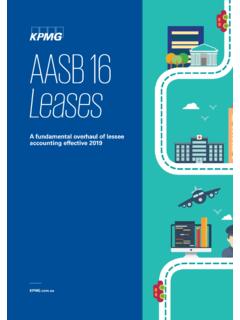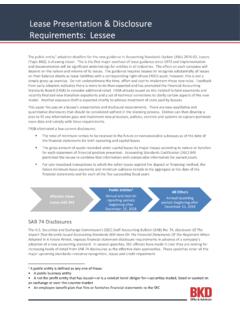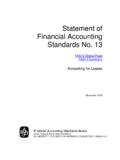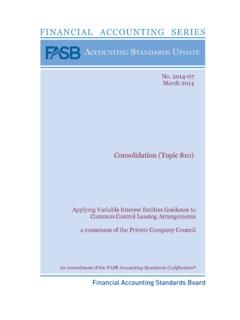Transcription of Applying IFRS: A closer look at the revised lease ...
1 A closer look at the revised lease accounting proposalMay 2013 Applying IFRS May 2013 Applying IFRS: A closer look at the revised lease accounting proposal 1 Contents In this issue: 1. Overview .. 4 2. Key considerations .. 4 Scope exclusions .. 4 Identifying a lease .. 5 Definition of a lease .. 5 Use of an identified asset .. 5 Right to control the use of the identified asset .. 7 Cancellable leases .. 9 Short-term leases .. 9 Separation of lease and non- lease components .. 9 Identifying and separating lease components and non- lease components .. 9 Identifying and separating lease components.
2 10 Allocating contract consideration .. 10 Changes to contracts .. 11 3. Key concepts .. 11 Significant economic incentive .. 11 lease term .. 12 lease payments .. 12 Fixed lease payments .. 13 lease incentives .. 13 Variable lease payments that depend on an index or rate .. 13 In-substance fixed lease payments .. 13 Purchase options .. 13 lease termination penalties or options .. 13 Residual value guarantees lessees .. 13 Residual value guarantees lessors .. 13 Variable lease payments not based on an index or rate .. 14 Discount rate .. 14 Lessees.
3 14 Lessors .. 14 2 May 2013 Applying IFRS: A closer look at the revised lease accounting proposal 4. lease classification .. 15 5. lessee accounting .. 17 Initial recognition and measurement .. 17 Subsequent measurement .. 17 Type A leases .. 17 Type B leases .. 19 Reassessment .. 21 Other lessee matters .. 22 Impairment .. 22 lease incentives .. 22 Presentation .. 23 Disclosure .. 24 6. Lessor accounting .. 24 Type A leases .. 24 Initial recognition and measurement .. 24 lease receivable .. 24 Residual asset .. 25 Profit .. 26 Subsequent measurement.
4 27 Reassessment .. 29 Impairment of lease receivables .. 30 Impairment of the residual asset .. 31 Type B leases .. 31 Presentation .. 32 Disclosure .. 33 7. Other considerations .. 33 Subleases .. 33 Business combinations .. 33 Sale and leaseback transactions .. 34 8. Effective date and transition .. 34 Effective date .. 34 Transition approaches .. 35 3 May 2013 Applying IFRS: A closer look at the revised lease accounting proposal What you need to know The IASB and the FASB have proposed that lessees be required to recognise assets and liabilities arising from their involvement in most leases.
5 Entities would still classify leases, but they would use different criteria for a different purpose. lease classification would determine how entities recognise lease -related revenue and expense, as well as what lessors record on the balance sheet. Classification would be based on the portion of the economic benefits of the underlying asset that are expected to be consumed by the lessee over the lease term. The IASB and the FASB are expected to devote significant outreach efforts on this project. Comments on the exposure draft are due by 13 September 2013. 4 May 2013 Applying IFRS: A closer look at the revised lease accounting proposal 1.
6 Overview The joint proposal by the International accounting Standards Board (IASB) and the Financial accounting Standards Board (FASB) (collectively, the Boards) would significantly change the accounting for leases and could have far-reaching implications for an entity s finances and operations. The exposure draft (ED or proposal) features a right-of-use model that would require lessees to recognise most leases on their balance sheets as lease liabilities with corresponding right-of-use assets. Like IAS 17 Leases, the proposal would require lessees and lessors to classify leases by type but the criteria for classifying leases and the related accounting would be different.
7 Under the proposal, leases would be classified as either Type A or Type B and this would be used principally for determining the method and timing for recognising lease revenue and expense. The proposal would require entities to adopt the new requirements using either a full retrospective or a modified retrospective approach. An effective date has not yet been proposed. Two of the IASB s 14 voting members voted against issuing the ED for comment, in part, because of the dual accounting model. Three of the seven FASB members voted against issuing it for various reasons, including the dual accounting model.
8 FASB Chair Leslie Seidman voted to issue the proposal, but her term on the FASB expires at the end of June 2013. Her departure will create a vacancy on the FASB that adds to the uncertainty about how the Boards will proceed. These circumstances make feedback on the ED from preparers and users of the financial statements critical. Comments are due by 13 September 2013. The complete ED and instructions for submitting comment letters are available on the IASB s website. Interested parties should also participate in the Boards planned outreach, which the Boards staffs have indicated will include roundtables and meetings with preparer and user groups most affected by the proposal.
9 2. Key considerations Scope exclusions Under the ED, the proposed accounting for leases would apply to leases of all assets except for the following leases, which would be specifically excluded under the proposal: Lessors leases of intangible assets Leases to explore for or use natural resources ( , minerals, oil, natural gas and similar non-regenerative resources) Leases of biological assets Service concession arrangements within the scope of IFRIC 12 Service Concession Arrangements Lessees leases of intangible assets would not be required to be accounted for as leases under the IASB s proposal.
10 This leaves open the possibility that an entity could choose, presumably as an accounting policy election, to account for leases of intangible assets under the proposed leases standard. In a change from the 2010 ED, leases of property that meet the definition of investment property in IAS 40 Investment Property are included in the scope of the We do not expect a final leases standard to be effective before 2017. May 2013 Applying IFRS: A closer look at the revised lease accounting proposal 5 proposal. In addition, the proposal would require a lessee to measure right-of-use assets arising from leased property in accordance with the fair value model of IAS 40 if the leased property meets the definition of investment property and the lessee elects the fair value model in IAS 40 as an accounting policy.















